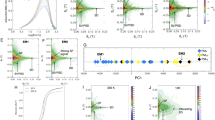Abstract
In this preliminary study I investigate the possibility of using magnetic techniques to analyse particulate matter trapped within the lung tissue from four deceased animals from in and near Munich, Germany. This is the first in vitro magnetic analysis of animal lung tissue. The four animals were three cats and a dog. The animals had not been studied in any previous laboratory experiments, and it is assumed that the magnetic signature was from particulate matter trapped within the lungs; however, the bulk analysis in this study did not discriminate between a biogenic or inorganic origin of the magnetic signal. Magnetic measurements were made on sub-samples of each lung. To fix the magnetic minerals within the lung tissue, the samples were cooled to 77 K, and their saturation isothermal remanence measured. For a few select samples the isothermal remanence acquisition curves were measured, plus thermomagnetic warming curves. The findings suggest that the main magnetic mineral is magnetite-like, in small concentrations (∼100s ppb) and likely consists of particles <100 nm in size. This is consistent with the magnetic signature of urban particulate matter thought to be of vehicular origin The cat from the countryside was found to have a magnetic concentration ∼50% that of the two urban cats, however, this cat was also significantly younger. The countryside dog had a concentration slightly higher than that of the two urban cats; however, the data set is too small to be statistically significant.
Similar content being viewed by others
References
Brem F., Hirt A.M., Winklhofer M., Frei K., Yonekawa Y., Wieser H.-G. and Dobson J., 2006. Magnetic iron compounds in the human brain: a comparison of tumour and hippocampal tissue. J. R. Soc. Inter., 3, 833–841, DOI: 10.1098/rsif.2006.0133.
Chen L.C. and Lippmann M., 2009. Effects of metals within ambient air particulate matter (PM) on human health. Inhal. Tox., 21, 1–31, DOI: 10.1080/08958370802105405.
Edelman N.B., Fritz T., Nimpf S., Pichler P., Lauwers M., Hickman R.W., Papadaki-Anastasopoulou A., Ushakova L., Heuser T., Resch G.P., Saunders M., Shaw J.A. and Keays D.A., 2015. No evidence for intracellular magnetite in putative vertebrate magnetoreceptors identified by magnetic screening. Proc. Natl. Acad. Sci. U. S. A., 112, 262–267, DOI: 10.1073/pnas.1407915112.
Eder S.H.K., Cadiou H., Muhamad A., McNaughton P.A., Kirschvink J.L. and Winklhofer M., 2012. Magnetic characterization of isolated candidate vertebrate magnetoreceptor cells. Proc. Natl. Acad. Sci. U. S. A., 109, 12022–12027, DOI: 10.1073/pnas.1205653109.
Gietl J.K., Lawrence R., Thorpe A.J. and Harrison R.M., 2010. Identification of brake wear particles and derivation of a quantitative tracer for brake dust at a major road. Atmos. Environ., 44, 141–146, DOI: 10.1016/j.atmosenv.2009.10.016.
Heslop D., Dekkers M.J., Kruiver P.P. and van Oorschot I.H.M., 2002. Analysis of isothermal remanent magnetization acquisition curves using the expectation-maximization algorithm. Geophys. J. Int., 148, 58–64.
Hildemann L.M., Markowski G.R., Jones M.C. and Cass G.R., 1991. Submicrometer aerosol mass distributions of emissions from boilers, fireplaces, automobiles, diesel trucks, and meatcooking operations. Aerosol Sci. Technol., 14, 138–152, DOI: 10.1080/02786829108959478.
Hofman J., Wuyts K., Van Wittenberghe S., Brackx M. and Samson R., 2014. On the link between biomagnetic monitoring and leaf-deposited dust load of urban trees: Relationships and spatial variability of different particle size fractions. Environ. Pollut., 192, 285–294, DOI: 10.1016/j.envpol.2014.05.006.
Kennedy P. and Gadd J., 2003. Preliminary Examination of Trace Elements in Tyres, Brake Pads, and Road Bitumen in New Zealand. Ministry of Transport, Auckland, New Zealand.
Kirschvink J.L., Kobayashikirschvink A. and Woodford B.J., 1992. Magnetite biomineralization in the human brain. Proc. Natl. Acad. Sci. U. S. A., 89, 7683–7687.
Könczöl M., Ebeling S., Goldenberg E., Treude F., Gminski R., Giere R., Grobety B., Rothen-Rutishauser B., Merfort I. and Mersch-Sundermann V., 2011. Cytotoxicity and genotoxicity of size-fractionated iron oxide (magnetite) in A549 human lung epithelial cells: Role of ROS, JNK, and NF-kappa B. Chem. Res. Toxicol., 24, 1460–1475, DOI: 10.1021/tx200051s.
Könczöl M., Weiss A., Stangenberg E., Gminski R., Garcia-Kaeufer M., Giere R., Merfort I. and Mersch-Sundermann V., 2013. Cell-cycle changes and oxidative stress response to magnetite in A549 human lung cells. Chem. Res. Toxicol., 26, 693–702, DOI: 10.1021/tx300503q.
Lough G.C., Schauer J.J., Park J.S., Shafer M.M., Deminter J.T. and Weinstein J.P., 2005. Emissions of metals associated with motor vehicle roadways. Environ. Sci. Technol., 39, 826–836, DOI: 10.1021/es048715f.
Matzka J. and Maher B.A., 1999. Magnetic biomonitoring of roadside tree leaves: identification of spatial and temporal variations in vehicle-derived particulates. Atmos. Environ., 33, 4565–4569.
Muxworthy A.R., Matzka J. and Petersen N., 2001. Comparison of magnetic parameters of urban atmospheric particulate matter with pollution and meteorological data. Atmos. Environ., 35, 4379–4386.
Muxworthy A.R. and McClelland E., 2000. Review of the low-temperature magnetic properties of magnetite from a rock magnetic perspective. Geophys. J. Int., 140, 101–114.
Muxworthy A.R., Schmidbauer E. and Petersen N., 2002. Magnetic properties and Mossbauer spectra of urban atmospheric particulate matter: a case study from Munich, Germany. Geophys. J. Int., 150, 558–570.
Sagnotti L., Macri P., Egli R. and Mondino M., 2006. Magnetic properties of atmospheric particulate matter from automatic air sampler stations in Latium (Italy): Toward a definition of magnetic fingerprints for natural and anthropogenic PM10 sources. J. Geophys. Res., 111, DOI: 10.1029/2006jb004508.
Sagnotti L., Taddeucci J., Winkler A. and Cavallo A., 2009. Compositional, morphological, and hysteresis characterization of magnetic airborne particulate matter in Rome, Italy. Geochem. Geophys. Geosyst., 10, DOI: 10.1029/2009gc002563.
WHO, 2006. Air Quality Guidelines. Global Update 2005. Particulate Matter, Ozone, Nitrogen Dioxide and Sulfur Dioxide. World Health Organization, Geneva, Switzerland
Author information
Authors and Affiliations
Corresponding author
Rights and permissions
About this article
Cite this article
Muxworthy, A.R. Investigation of magnetic particulate matter inside animals’ lung tissue: preliminary results. Stud Geophys Geod 59, 628–634 (2015). https://doi.org/10.1007/s11200-014-0777-6
Received:
Revised:
Accepted:
Published:
Issue Date:
DOI: https://doi.org/10.1007/s11200-014-0777-6




